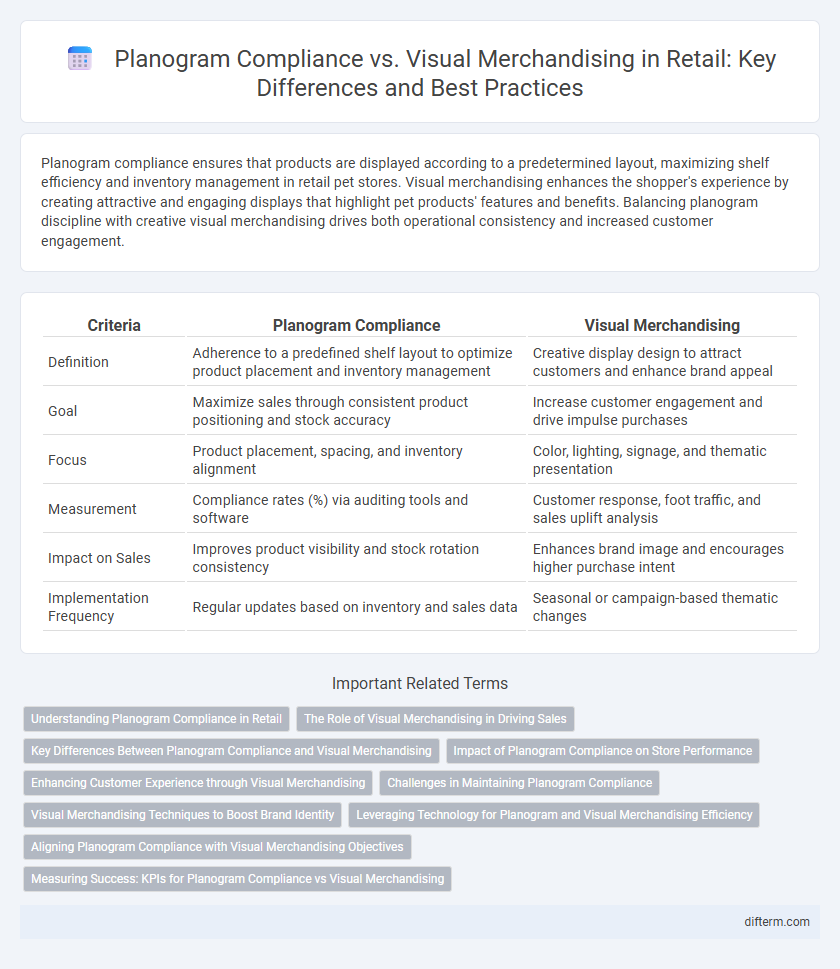Planogram compliance ensures that products are displayed according to a predetermined layout, maximizing shelf efficiency and inventory management in retail pet stores. Visual merchandising enhances the shopper's experience by creating attractive and engaging displays that highlight pet products' features and benefits. Balancing planogram discipline with creative visual merchandising drives both operational consistency and increased customer engagement.
Table of Comparison
| Criteria | Planogram Compliance | Visual Merchandising |
|---|---|---|
| Definition | Adherence to a predefined shelf layout to optimize product placement and inventory management | Creative display design to attract customers and enhance brand appeal |
| Goal | Maximize sales through consistent product positioning and stock accuracy | Increase customer engagement and drive impulse purchases |
| Focus | Product placement, spacing, and inventory alignment | Color, lighting, signage, and thematic presentation |
| Measurement | Compliance rates (%) via auditing tools and software | Customer response, foot traffic, and sales uplift analysis |
| Impact on Sales | Improves product visibility and stock rotation consistency | Enhances brand image and encourages higher purchase intent |
| Implementation Frequency | Regular updates based on inventory and sales data | Seasonal or campaign-based thematic changes |
Understanding Planogram Compliance in Retail
Planogram compliance in retail ensures products are displayed precisely according to a pre-designed layout, optimizing shelf space and enhancing inventory management. This adherence directly impacts sales performance by increasing product visibility and customer engagement. Visual merchandising supports planogram compliance by creating appealing displays that maintain brand consistency and attract shoppers' attention.
The Role of Visual Merchandising in Driving Sales
Visual merchandising plays a pivotal role in driving sales by strategically arranging products to enhance customer engagement and optimize store layout in line with planogram guidelines. Effective visual merchandising ensures product visibility and accessibility, encouraging impulse purchases and reinforcing brand messaging. Adherence to planogram compliance maximizes shelf space utilization and maintains a consistent shopping experience, directly influencing consumer buying behavior and increasing overall retail profitability.
Key Differences Between Planogram Compliance and Visual Merchandising
Planogram compliance ensures that products are arranged in accordance with a predefined layout designed to maximize sales and optimize shelf space, while visual merchandising focuses on creating an attractive and engaging in-store environment to enhance the customer experience. Planogram compliance relies heavily on data-driven directives and strict adherence to product placement, whereas visual merchandising allows for creative flexibility to influence shopper behavior and brand perception. Together, these approaches balance operational precision with aesthetic appeal to drive retail success.
Impact of Planogram Compliance on Store Performance
Planogram compliance directly influences store performance by ensuring consistent product placement, which enhances inventory management and maximizes shelf space utilization. High compliance rates increase product visibility and shopper convenience, driving higher sales and improving customer satisfaction. Effective visual merchandising without adherence to planograms risks inconsistent displays, leading to reduced operational efficiency and lost revenue opportunities.
Enhancing Customer Experience through Visual Merchandising
Visual merchandising strategically arranges products to create an engaging shopping environment that enhances the customer experience and drives sales. Planogram compliance ensures consistent product placement across stores, supporting brand standards and simplifying customer navigation. Combining planogram adherence with creative visual merchandising maximizes product visibility and entices shopper interaction, leading to increased satisfaction and loyalty.
Challenges in Maintaining Planogram Compliance
Maintaining planogram compliance presents challenges such as inconsistent product placement due to frequent inventory changes and staff turnover, leading to diminished shelf organization and brand visibility. Visual merchandising efforts may conflict with strict planogram guidelines, causing discrepancies that reduce overall store aesthetics and customer experience. Ensuring continuous training and frequent audits are essential to align merchandising creativity with precise planogram execution.
Visual Merchandising Techniques to Boost Brand Identity
Visual merchandising techniques such as strategic product placement, color coordination, and thematic displays significantly enhance brand identity by creating immersive shopping experiences that resonate with target customers. Effective use of lighting, signage, and mannequins draws attention to key products while reinforcing brand values and storytelling. Consistent visual merchandising aligned with brand guidelines strengthens consumer recognition and differentiates retail spaces in competitive markets.
Leveraging Technology for Planogram and Visual Merchandising Efficiency
Leveraging technology in retail enhances planogram compliance by utilizing AI-driven shelf-scanning tools that ensure product placement accuracy and real-time inventory monitoring. Digital planogram software streamlines visual merchandising by enabling dynamic adjustments and personalized displays based on sales data and customer behavior analytics. Integration of augmented reality (AR) solutions allows retailers to visualize and optimize store layouts, increasing merchandising efficiency and driving sales growth.
Aligning Planogram Compliance with Visual Merchandising Objectives
Aligning planogram compliance with visual merchandising objectives ensures consistent product placement that enhances brand identity and improves shopper experience. Effective integration optimizes shelf space utilization, boosts sales performance, and strengthens customer engagement through strategic visual appeal. Retailers achieve higher operational efficiency by balancing standardized layouts with creative merchandising tailored to target demographics.
Measuring Success: KPIs for Planogram Compliance vs Visual Merchandising
Measuring success in retail relies on KPIs such as shelf compliance rates, inventory accuracy, and sales lift for planogram compliance, which ensures products are displayed according to design specifications. Visual merchandising success is evaluated through customer engagement metrics, dwell time, and conversion rates, reflecting the impact of store aesthetics on shopper behavior. Combining these KPIs provides a comprehensive understanding of how layout adherence and visual appeal drive overall retail performance.
Planogram compliance vs Visual merchandising Infographic

 difterm.com
difterm.com